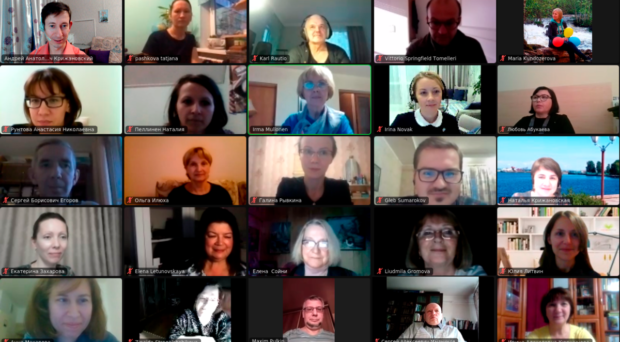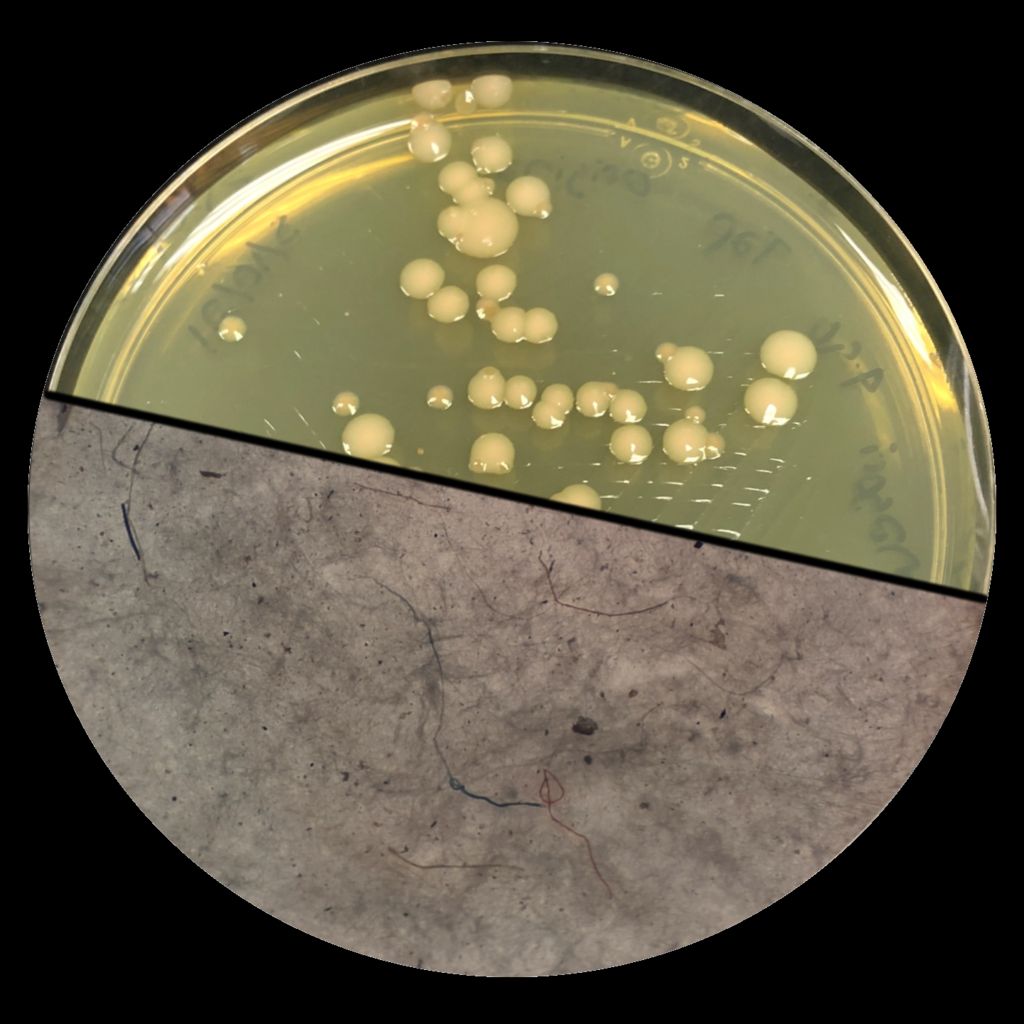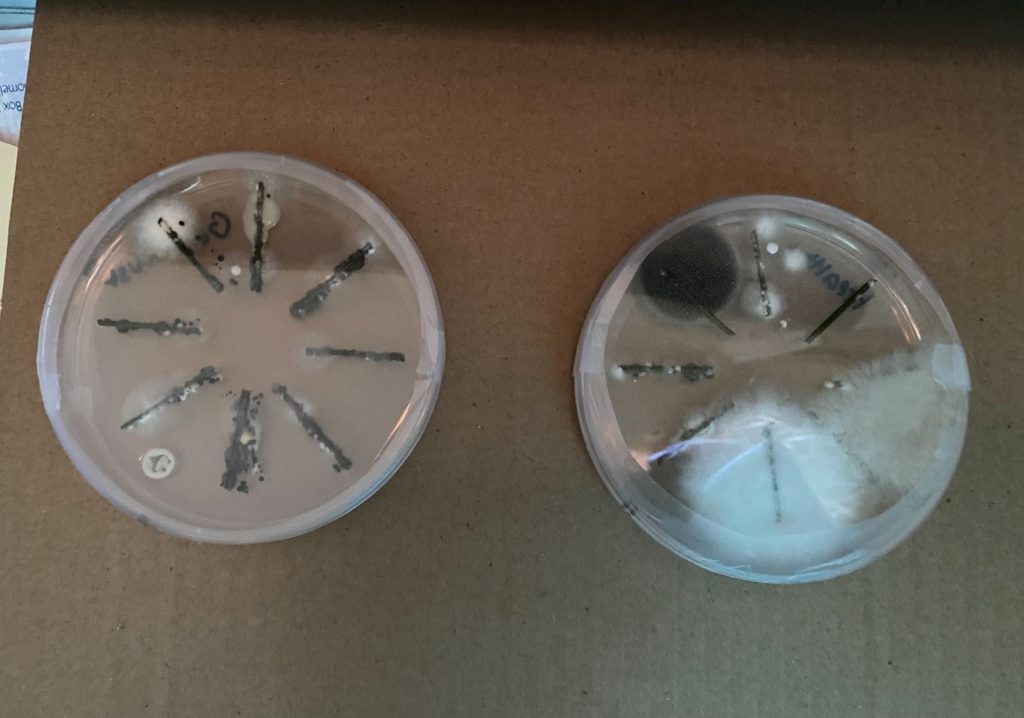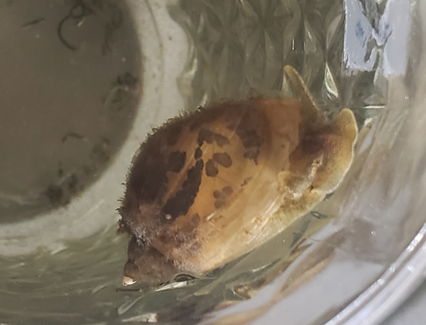
The ongoing COVID-19 pandemic, still raging across the globe, has highlighted the importance of educating the public about concepts in disease ecology, such as the socioecological impact of infectious diseases, and the interrelated nature of our human and natural world. This is particularly true for future professionals in health care and other applied sciences, such as the students I teach in the BSc in Biology program at Eastern Washington University.
When I started teaching my Senior Capstone class in Disease Ecology, I first chose the traditional approach, lecturing to the students 4 days a week, covering the chapters of my textbook, with my occasional Socratic questions only being answered by the few dedicated students in the class. However, I quickly realized that student participation, attendance and attention was lackluster, and I had doubts whether they even read the assigned readings. I attempted to solve this by assigning specific book chapters for group of students to present on to the rest of the class. This was successful in that the particular group of students presenting on a chapter certainly had to read and understand the content, but I wasn’t sure the other students in the class did. When I asked questions after their presentation, I had to frequently provide answers to my own questions, so I felt like I’m conducting a discussion with myself with the students just listening in. I was not happy with this, and was looking for better teaching methods.
When the COVID-19 pandemic hit Spring 2020, I was forced to completely revamp my class. I recorded Powerpoint lectures associated with each book chapter, and created reading quizzes that forced students to do the readings. However, I taught the class asynchronously, without meeting the students either in person or over Zoom, except for a few times to discuss their group research project. I did feel isolated from the students, and did not get to know them as I would have if we spent 10 weeks face-to-face in the classroom. While I provided explanations and elaborated on the book chapters in my recorded lectures, there was no discussion incorporated into the class, and therefore I had no feedback on how well the students understood the concepts of disease ecology, other than their scores on the reading quizzes.
Virtual classes remained the predominant mode of instruction at Eastern Washington University throughout the 2020-21 academic year, except for some selected classes approved for in-person instruction. However, classes were taught synchronously, meeting at least part of the time over Zoom for classes. This allowed me to meet with my students again every day of the week, although virtually. Students were still expected to read the book chapters, watch the associated recorded Powerpoint lectures, and complete the reading quizzes before coming to class. Instead of lecturing, I devoted class-time to discussion of the material with the students, using a free version of PollEverywhere (an audience response system) to collect anonymous responses of the students to my questions through a phone or web-based app. Students were awarded points for both participation and getting the question correct for extra credit. I would read the book chapters myself and create a list of questions for our upcoming class. The questions would be more challenging than typical quiz questions, mostly open-ended and complex, rather than multiple choice or simple True/False questions. I would start each chapter discussion with asking the students about any unfamiliar terms or concepts from the book chapter that they would like me to address during our discussion. Students would frequently highlight terms that I expected them to get confused about (e.g. the dilution effect), but sometimes also unexpected terms that I assumed they already knew (e.g. homogeneous). As we went through my questions, if most students would get their answers correct, I would just move on. However, if at least 20% of the class got the question wrong, I would address the issue, and explain why their answer was incorrect, and what the correct answer would have been, and why. Since students were allowed to change their responses, I could see how they would change their responses to fit what I said – whether or not that resulted in more understanding or just imitation, I cannot judge.
This new kind of instruction, with lectures and readings done at home before class, and class-time spent on discussion, practice and application, is termed a “flipped class” design, and has been rising in popularity for a while, with substantial benefits in student participation and active learning. I also use this type of course design in other classes, and I was planning to “flip” my Disease Ecology class previously, but now the COVID-19 pandemic has forced me to do that. Participation increased dramatically in the class, with most students responding to the questions (especially multiple choice ones), many more than the few dedicated students that answered rhetorical questions in person. I certainly enjoyed this kind of interaction with my students much more than straight lecturing of the same stuff over-and-over, and I believe some of my students also enjoyed the discussions (although one anonymous response said that a “one-hour talk could be replaced by an email” – I guess I talk too much!). It was definitely great to “see” my students every day, and I developed more of a connection with them than with the previous cohort.
Hopefully, during the Spring 2022, I will be able to teach my Disease Ecology class in person, with the students in the classroom every day. However, I will keep the “flipped” design of my class, devoting class-time to this discussion using PollEverywhere to motivate everyone to participate, with readings done and lectures watched before class. This will be the silver lining and the benefit that the COVID-19 pandemic has brought to my class. One thing I missed this year was the ability to identify underlying causes of confusion or misunderstanding of certain concepts (e.g. the persistence of a pathogen in a population). When I saw students answer incorrectly, I was able to explain the concept again. However, I did not have an easy ability to ask “why” they misunderstood it in the first place. By trying to do this, I will try to learn more from my students about what preconceptions and misconceptions they have, and try to work on clearing those up. I will also review my PollEverywhere questions to make sure they are still relevant and not confusing for the students due to their phrasing. Obviously, the textbook I use, however much I love it, is somewhat in need of revision at this point as well, if for nothing else the fact that it was written before the COVID-19 pandemic, which cannot be ignored in any Disease Ecology course. My longtime goal is to bring together the original authors of the book and the most prominent disease ecologists to update the book, providing more up-to-date information on some of the topics.
While above I focused mostly on the content of my class and it’s delivery, those of you who read my blogposts on my class in previous years might remember that a substantial part of this Disease Ecology Senior Capstone is the research projects that the students conduct in groups. Last year they all had to complete these projects at home, using supplies I sent them or they acquired themselves. This year, I had the ability to meet with some of the student groups in a limited manner, provide them with supplies, and even accompany them on a field trip to collect snails. As you’ll see below, the students completed quite interesting projects, ranging from microplastics and bacteria in different waters, mark-recapture of ticks, surveys of pine needle endosymbionts in pine gall-infected and healthy trees, looking for trematodes in aquatic snails, simulating COVID-19 spread in a dorm at our University under different conditions, and surveying local horse owners about their knowledge of West Nile virus and the vaccination status of their horses. The students did an excellent job, as you can read in the summaries of their projects below. However, I do know that their projects would have been even better if they had more access to the equipment, supplies and the expertise of our faculty and our staff overseeing their projects. Hopefully, we will be back in person next Spring, and I can support the students in my next Disease Ecology class even more! I can’t wait to do that!
Drinker Beware: Tap Water Has Fewer Bacteria Than Coastal Sources but Just as Much Microplastics as Coastal and Lake Waters
Danielle DeYoung, Elizabeth Fisher, Roxanne McPeck and Yana Murro Te
 Microplastics (plastic fragments, particles, and fibers smaller than 5 mm) contaminate nearly every ecosystem on Earth. In this study, we sampled 15 coastal, lake, and tap waters, with the coastal samples coming from western Washington and the lake and tap waters originating from the Greater Spokane region. We cultured bacteria from this sample on TSA and counted colony-forming units (CFUs) to estimate bacterial abundance, and we also visually counted microplastics under a dissection microscope. We are sequencing the most abundant morphotype from each sample, but that work is ongoing. Every sample contained microplastics, with no significant differences across categories, including between coastal (marine) and tap water. Bacterial abundance did differ between categories with tap samples mostly growing non-countable numbers of colonies (with the notable exception of the town our university is in), but there was overall no correlation between microplastics and bacterial abundances. However, the discovery that microplastics occurred in every sample, including the five tap samples, should draw interest. Microplastics have been shown to have health effects beyond their association with bacteria and biofilms, so the knowledge that even tap water samples contain as much microplastics as environmental samples is an important conclusion to draw, and it’s necessary for future studies to establish safe microplastic consumption levels, as well as find ways to reduce microplastics in environmental and drinking waters. Good luck forgetting this knowledge the next time you get a glass of water from the sink!
Microplastics (plastic fragments, particles, and fibers smaller than 5 mm) contaminate nearly every ecosystem on Earth. In this study, we sampled 15 coastal, lake, and tap waters, with the coastal samples coming from western Washington and the lake and tap waters originating from the Greater Spokane region. We cultured bacteria from this sample on TSA and counted colony-forming units (CFUs) to estimate bacterial abundance, and we also visually counted microplastics under a dissection microscope. We are sequencing the most abundant morphotype from each sample, but that work is ongoing. Every sample contained microplastics, with no significant differences across categories, including between coastal (marine) and tap water. Bacterial abundance did differ between categories with tap samples mostly growing non-countable numbers of colonies (with the notable exception of the town our university is in), but there was overall no correlation between microplastics and bacterial abundances. However, the discovery that microplastics occurred in every sample, including the five tap samples, should draw interest. Microplastics have been shown to have health effects beyond their association with bacteria and biofilms, so the knowledge that even tap water samples contain as much microplastics as environmental samples is an important conclusion to draw, and it’s necessary for future studies to establish safe microplastic consumption levels, as well as find ways to reduce microplastics in environmental and drinking waters. Good luck forgetting this knowledge the next time you get a glass of water from the sink!

Tick density and distribution in the greater Spokane area
Mark Klimok, Michael Estrella, Joseph Hahnenkratt, Quinn Swanson, James Hurst, Michael Stralser
Ticks are a very common vector of disease in the Northwest for animals and humans alike. Because of this reason our group thought it would be interesting, as well as important, to study their distribution around hiking and walking trails surrounding Spokane, Washington. To do this we identified three common recreation areas for tick collection over a three week period. The ticks were collected at Turnbull National Wildlife Refuge, Riverside State Park, and Dishman Hills Conservation Area. A tick drag, made of burlap, was dragged along both sides of trails for 100 meters. If any ticks were collected they were then handled gently with tweezers and marked with nail polish and released. This marking of ticks with nail polish allowed us to determine if they had been caught in previous sessions. We recorded the temperature and humidity at each collection site to try and determine if they had an impact on tick numbers. Ticks were only marked the first and second week of capture as we had no use to mark them after our final collection. From the literature we read, our group expected to find less ticks as the season became dryer, while finding more ticks in areas with more vegetation ground cover. To the right is an image of a tick that was collected.
A Survey of Endosymbionts in Pine Trees With and Without Gall Rust
Makenna Britton, Emily Burke, Cameron Headlee, Liz Parsley, Samantha Rehm, Brandon Stanley, and Meagan Stevens
 Pine gall rust is a common fungal disease found on pine trees in the Pacific Northwest. It is caused by the fungus Peridermium harknessii which grows in the cambium of the tree and results in large, bulbous, galls on the branches. Endosymbionts have the ability to alter host-pathogen interactions, and we examined this by looking at the difference in abundance and diversity of fungal endosymbionts present. Using pine needle samples from Pinus ponderosa and Pinus contorta, we compared pine needles samples with P. harknessii and without. This was achieved by collecting pine needle samples from trees in multiple geographical regions in Washington, and one region in California. Samples were then inoculated by plating in potato dextrose agar plates and observed visually for bacterial growth colonies. Colonies were quantified and identified by visual analysis and matched to known fungal types. A summary of the results of this study showed that 47.4% of unhealthy and healthy pine trees had colonies present, while 5.3% of healthy tree plates did not contain any colonies. All unhealthy plates contained colonial growth. An ANOVA test was performed to quantify the endosymbionts, giving an average of 6.3 and p-value of 0.49. We observed morphological differences on the plates as well. The ANOVA test for this indicated an average of 2.0 and p-value of 1.0. Data from the ANOVA tests show there was not a significant difference between abundance of endosymbionts in healthy and unhealthy trees, contrary to our prediction. The relationship between pine trees and the effects of P. harknessii can further be investigated by focusing on a singular species of pine tree, as well as observing the effects of pine-oak gall rust and comparing these two communities.
Pine gall rust is a common fungal disease found on pine trees in the Pacific Northwest. It is caused by the fungus Peridermium harknessii which grows in the cambium of the tree and results in large, bulbous, galls on the branches. Endosymbionts have the ability to alter host-pathogen interactions, and we examined this by looking at the difference in abundance and diversity of fungal endosymbionts present. Using pine needle samples from Pinus ponderosa and Pinus contorta, we compared pine needles samples with P. harknessii and without. This was achieved by collecting pine needle samples from trees in multiple geographical regions in Washington, and one region in California. Samples were then inoculated by plating in potato dextrose agar plates and observed visually for bacterial growth colonies. Colonies were quantified and identified by visual analysis and matched to known fungal types. A summary of the results of this study showed that 47.4% of unhealthy and healthy pine trees had colonies present, while 5.3% of healthy tree plates did not contain any colonies. All unhealthy plates contained colonial growth. An ANOVA test was performed to quantify the endosymbionts, giving an average of 6.3 and p-value of 0.49. We observed morphological differences on the plates as well. The ANOVA test for this indicated an average of 2.0 and p-value of 1.0. Data from the ANOVA tests show there was not a significant difference between abundance of endosymbionts in healthy and unhealthy trees, contrary to our prediction. The relationship between pine trees and the effects of P. harknessii can further be investigated by focusing on a singular species of pine tree, as well as observing the effects of pine-oak gall rust and comparing these two communities.
Survey of Radix auricularia and trematode prevalence in three lakes at Turnbull National Wildlife Refuge
Belén Longoria, Kristina Hopkins, and Taylor Baldwin
 We all know of the common garden snail, but the star of the show here is the freshwater pulmonate gastropod mollusk (what a mouthful!), Radix auricularia. This is an invasive species originating from Europe and Asia. It has a patch-like distribution in the U.S, which likely resulted from multiple introductions. In 1968 the first observation of R. auricularia was reported at Upper Pines Lake in Turnbull National Wildlife Refuge (TNWR), Cheney,WA. These gastropods are known to be an intermediate host for trematodes; thus, we were interested in investigating the presence of trematodes in R. auricularia at TNWR. Three lakes were surveyed for Radix—Middle Pines Lake, Blackhorse Lake, and Kepple Lake. These sites were chosen based on previous research that determined gastropod diversity at TNWR— Radix abundance was 83.6% at Middle Pines Lake, 10.9% at Kepple Lake, and 0.40% at Blackhorse Lake.
We all know of the common garden snail, but the star of the show here is the freshwater pulmonate gastropod mollusk (what a mouthful!), Radix auricularia. This is an invasive species originating from Europe and Asia. It has a patch-like distribution in the U.S, which likely resulted from multiple introductions. In 1968 the first observation of R. auricularia was reported at Upper Pines Lake in Turnbull National Wildlife Refuge (TNWR), Cheney,WA. These gastropods are known to be an intermediate host for trematodes; thus, we were interested in investigating the presence of trematodes in R. auricularia at TNWR. Three lakes were surveyed for Radix—Middle Pines Lake, Blackhorse Lake, and Kepple Lake. These sites were chosen based on previous research that determined gastropod diversity at TNWR— Radix abundance was 83.6% at Middle Pines Lake, 10.9% at Kepple Lake, and 0.40% at Blackhorse Lake.
We collected for one day but made the most of it. We strapped on some waders and took for the waters, grazing our nets across concentrated areas of vegetation and scooping sediment, sifting our nets for any snails greenish tan in color with tan shells and black speckles. 50 snails were collected in total, composed of three genera—Radix, Gyraulus, and Lymnaea. 20 Radix were collected from Middle Pines Lake and one Radix from Blackhorse Lake. The snails were transferred to individual jars containing tap water and placed under lamps to stimulate cercariae shedding. Cercariae are the larval and infectious forms of trematodes. No trematodes were observed in the samples, but other aquatic invertebrates were found in the water with the snails. Nonparasitic nematodes, freshwater oligochaetes, and Diptera larvae in the family Chironomidae. Overall, our findings show that gastropods are hosts for other organisms and a reduced abundance of Radix at Kepple Lake.

COVID-19 Modeling at Eastern Washington University Dormitories
Ryiah Horton
The COVID-19 pandemic has demonstrated the importance of understanding how disease interactions work, not only for those who study these interactions but for everyone. The need for every person to understand how public health measures impact the spread of diseases has never been more important either. The COVID-ADAPT model, created by Dr. Krisztian Magori, is an event-based stochastic SEIR (Susceptible-Exposed-Infectious-Recovered) airborne disease model based on the first floor of Pearce Hall on Eastern Washington University’s Cheney campus. The model separates individuals into 6 distinct categories: infectious unmasked individuals, susceptible vaccinated unmasked individuals, susceptible unvaccinated unmasked individuals, infectious masked individuals, susceptible vaccinated masked individuals, and susceptible unvaccinated masked individuals. The 6 distinct categories allow for two of the three public health measures to be observed (masking and vaccinations); the third public health measure, social distancing, is modeled through decreased occupancy of the space provided. 10 different scenarios were set up using the combinations of these public health measures: 16 person and 32 person control, 16 and 32 person 75% masking, 16 and 32 person 75% vaccination, 16 and 32 person 75% masking and 75% vaccination, and 16 and 32 person 100% masking and 75% vaccinations. Each scenario was run 25 times containing 4 infectious individuals. The results of the study suggest that any combination of public health measures that include masking significantly reduces COVID-19 spread. Vaccinations in the model are assumed to be only effective 80% of the time; this means that if a susceptible individual stays in a sufficiently infected space, for every event (approximately one minute), they would have an 80% chance of being protected from getting infected. The reality of how the COVID-19 vaccine protects individuals from infection is most likely not the way the model currently simulates vaccine efficacy; this would explain the discrepancy between previous literature and the model as it stands.
West Nile Virus and Domesticated Horse Survey Study
Laura Mertens-Plowman, Alexis Miller, Leanne Poole, and Emma Seely
Vaccinations for horses against common diseases in the Northwest are used to protect them from debilitating and deadly diseases. West Nile virus (WNV) is one of those diseases that is included in the recommendations for vaccination by the USDA, as well as local veterinarians. West Nile virus is a disease that transfers from mosquitoes to horses that causes major neurological symptoms and even death to occur. Horses in particular have a much higher rate of infection than humans, making the recommended vaccine schedule especially important to follow. The objectives of this study were to determine the rate of vaccination for West Nile virus, per horse, in Spokane County, Washington and explore the reasons that people choose to vaccinate or not vaccinate, including a focus on the correlation between the horse owner’s knowledge level of West Nile virus and corresponding decision to vaccinate or not. We used online surveys, as well as printed versions of our survey to conduct this study. We collected data both through social media outlets and in person at local veterinary clinics. We predicted that there would be a correlation between knowledge level and vaccination rates, with horse owners who had lower knowledge levels less likely to vaccinate and horse owners with higher knowledge levels more likely to vaccinate. We anticipated that the results from this study would contribute to the understanding of why people decide to vaccinate or not vaccinate their horses for West Nile virus, which could be applied to improving the methods of public officials and local veterinarians to increase vaccination rates locally. We found that a large majority of local horse owners are aware of WNV and choose to vaccinate against it. However, when analyzing the data, to our surprise, we did not find significant data to support our hypothesis that a higher owner knowledge base would impact their decisions and cause them to vaccinate. In addition, there was statistical significance when analyzing the correlation between owner’s trust in veterinary recommendation and their choice to vaccinate their horses for WNV.

Comments